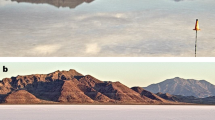Abstract
We examine conductances for evaporation from both vegetation and soil in response to environmental variables. Data from a vertically-structured pristine forest of Nothofagus are presented as an example of the effects of biodiversity on the scaling of conductances between tiers of plant organisation. Available data sets of maximum leaf stomatal conductances (g lmax ) and bulk vegetation surface conductances (G smax ) are compared. Overall, the ratio G smax /g lmax is consistently close to 3 for seven major vegetation types of diverse structure. An analytical model accounts for this close relationship, and in particular how G smax is conservative against changes in leaf area index because of the compensating decrease in plant canopy transpiration and increase in soil evaporation as leaf area index diminishes. The model is also successfully tested by comparison with canopy conductances of emergent trees measured in the Nothofagus forest. The constraint of vegetation surface conductance and evaporation via environmental regulation by irradiance, air saturation deficit and root zone water supply are discussed.
Similar content being viewed by others
References
Alphalo, P.J. & Jarvis, P.G. 1991. Do stomata respond to relative humidity? Plant, Cell and Environment 14: 127–132.
Alphalo, P.J. & Jarvis, P.G. 1993. The boundary layer and the apparent responses of stomatal conductance to wind speed and to the mole fractions of CO2 and water vapour in the air. Plant, Cell and Environment 16: 771–783.
Dolman, A.J., Gash, J.H.C., Roberts, J. & Shuttleworth, W.J. 1991. Stomatal and surface conductance of tropical rainforest. Agricultural and Forest Meteorology 54: 303–318.
Grace J. 1993. Consequences of xylem cavitation for plant water deficits. In: Smith, J.A.C. & Griffiths, H. (eds), Water deficits, Plant responses from cell to community. Bios Scientific Publishers, pp. 109–128.
Jarvis, P.G. 1976. The interpretation of the variation in leaf water potential and stomatal conductance found in canopies in the field. Phil. Trans. Roy. Soc. London Ser. B 273: 593–610.
Jarvis, P.G. & McNaughton, K.G. 1986. Stomatal control of transpiration: Scaling from leaf to region. Advances in Ecol. Res. 15: 1–49.
Kelliher, F.M., Köstner, B.M.M., Hollinger, D.Y., Byers, J.N., Hunt, J.E., McSeveny, T.M., Meserth, R., Weir, P.L. & Schulze, E.-D. 1992. Evaporation, xylem sap flow, and tree transpiration in a New Zealand broad-leaved forest. Agric. Forest Met. 62: 53–73.
Kelliher, F.M., Leuning, R. & Schulze, E.-D. 1993. Evaporation and canopy characteristics of coniferous forests and grasslands. Oecologia 95: 153–163.
Kelliher, F.M., Leuning, R., Raupach, M.R. & Schulze, E.-D. 1994. Maximum conductances for evaporation from global vegetation types. Agric. Forest Met. (in press).
Körner, Ch. 1994. Leaf diffusive conductances in the major vegetation types of the globe. In: Schulze, E.-D. & Caldwell, M.M. (eds), Ecophysiology of Photosynthesis. Ecological Studies 100. Springer Verlag, Berlin Heidelberg, New York, pp. 463–486.
Köstner, B.M.M., Schulze, E.-D., Kelliher, F.M., Hollinger, D.Y., Byers, J.N., Hunt, J.E., McSeveny, T.M., Meserth, R. & Weir, P.L. 1992. Transpiration and canopy conductance in a pristine broad-leaved forest of Nothofagus: An analysis of xylem sap flow and eddy correlation measurements. Oecologia 91: 350–359.
Leuning, R. 1994. A critical appraisal of a combined stomatal-photosynthesis model for C3 plants. Plant, Cell and Environment 17: 1061–1068.
Lohammer, T., Larsson, S. & Falk, S.O. 1980. FAST-simulation models of gaseous exchange in Scots pine. In: Persson, T. (ed), Structure and function in northern coniferous forests-An ecosystem study. Ecol. Bull., Vol. 32, Swedish Natural Science Council, Stockholm, pp. 505–523.
Lösch, R. & Schulze, E.-D. 1994. Internal coordination of plant responses to drought and evaporative demand. In: Schulze, E.-D. & Caldwell, M.M. (eds), Ecophysiology of Photosynthesis. Ecological Studies 100. Springer Verlag Berlin Heidelberg, pp. 185–204.
McNaughton, K.G. 1994. Effective stomatal and boundary-layer resistances of heterogenous surfaces. Plant, Cell and Environment 17: 1061–1068.
Monteith, J.L. & Unsworth, M.H. 1990. Principles of environmental physics, 2nd ed, Edward Arnold, London, 291 p.
Mott, K. & Parkhurst, D.F. 1991. Stomatal responses to humidity in air and helox. Plant, Cell and Environment 14: 509–515.
Nonami, H. Schulze, E.-D. & Ziegler, H. 1990. Mechanisms of stomatal movement in response to air humiditi, irradiance and xylem water potential. Planta 183: 57–64.
Philip, J.R. 1957. Evaporation, and moisture and heat fields in the soil. Journal of Meteorology 14: 354–366.
Raupach, M.R. & Finnigan, J.J. 1988. Single-layer models of evaporation from plant canopies are incorrect but useful, whereas, multilayer models are correct but useless: Discuss. Australian Journal of Plant Physiology 15: 705–716.
Raupach, M.R. 1994. Vegetation-atmosphere interaction and surface conductance at leaf, canopy and regional scales. Agric. For. Meteorol. (in press).
Saugier, B. & Katerji, N. 1991. Some plant factors controlling evapotranspiration. Agricultural and Forest Meteorology 54: 263–277.
Sharkey, T.D. & Raschke, K. 1981. Separation and measurement of direct and indirect effects of light on stomata. Plant Physiology 68: 33–40.
Schulze, E.-D. 1994. The regulation of plant transpiration: Interactions of feedforeward, feedback, and futile cycles. In: Schulze, E.-D. (ed), Flux control in biological systems. Academic Press, San Diego, pp. 203–236.
Schulze, E.-D. & Hall, A.E. 1982. Stomatal control of water loss. In: Lange, O.L., Nobel, P.S., Osmond, C.B. & Ziegler, H. (eds), Encyclopedia of Plant Physiology. Physiological Plant Ecology. Vol. 12B. Water relations and photosynthetic productivity Berlin, Heidelberg, pp. 181–230.
Schulze, E.-D., Kelliher, F.M., Körner, C., Lloyd, J. & Leuning, R. 1994. Relationships between maximum stomatal conductance, ecosystem surface conductance, carbon assimilation rate and plant nitrogen nutrition: A global ecology scaling exercise. Annu. Rev. Ecol. Syst. 25: 629–660.
Totsuka, T. 1963. Theoretical analysis of the relationship between water supply and dry-matter production of plant communities. J. of the Faculty of Science, University of Tokyo, section III, Botany, Vol. VIII. Part 9: 341–375.
Yera, R., Davis, S., Frazer, J. & Tallman, G. 1986. Responses of adaxial and abaxial stomata of normally oriented and inverted leaves of Vicia faba L. to light. Plant Physiology 82: 384–389.
Author information
Authors and Affiliations
Rights and permissions
About this article
Cite this article
Schulze, ED., Leuning, R. & Kelliher, F.M. Environmental regulation of surface conductance for evaporation from vegetation. Vegetatio 121, 79–87 (1995). https://doi.org/10.1007/BF00044674
Accepted:
Issue Date:
DOI: https://doi.org/10.1007/BF00044674




